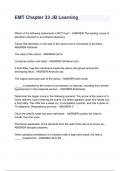Ensayo
Class differences in achievement - Sociology Education 30 Mark Essay
- Grado
- Institución
This document is an in-depth 30 mark Sociology essay. Each paragraph is colour-coded according to P.E.E.L (Point, Evidence, Explanation, and Link). Ideal for both teachers and students for AQA A-level Sociology. I personally achieved an A* in A Level Sociology so this is perfect for students who ar...
[Mostrar más]












